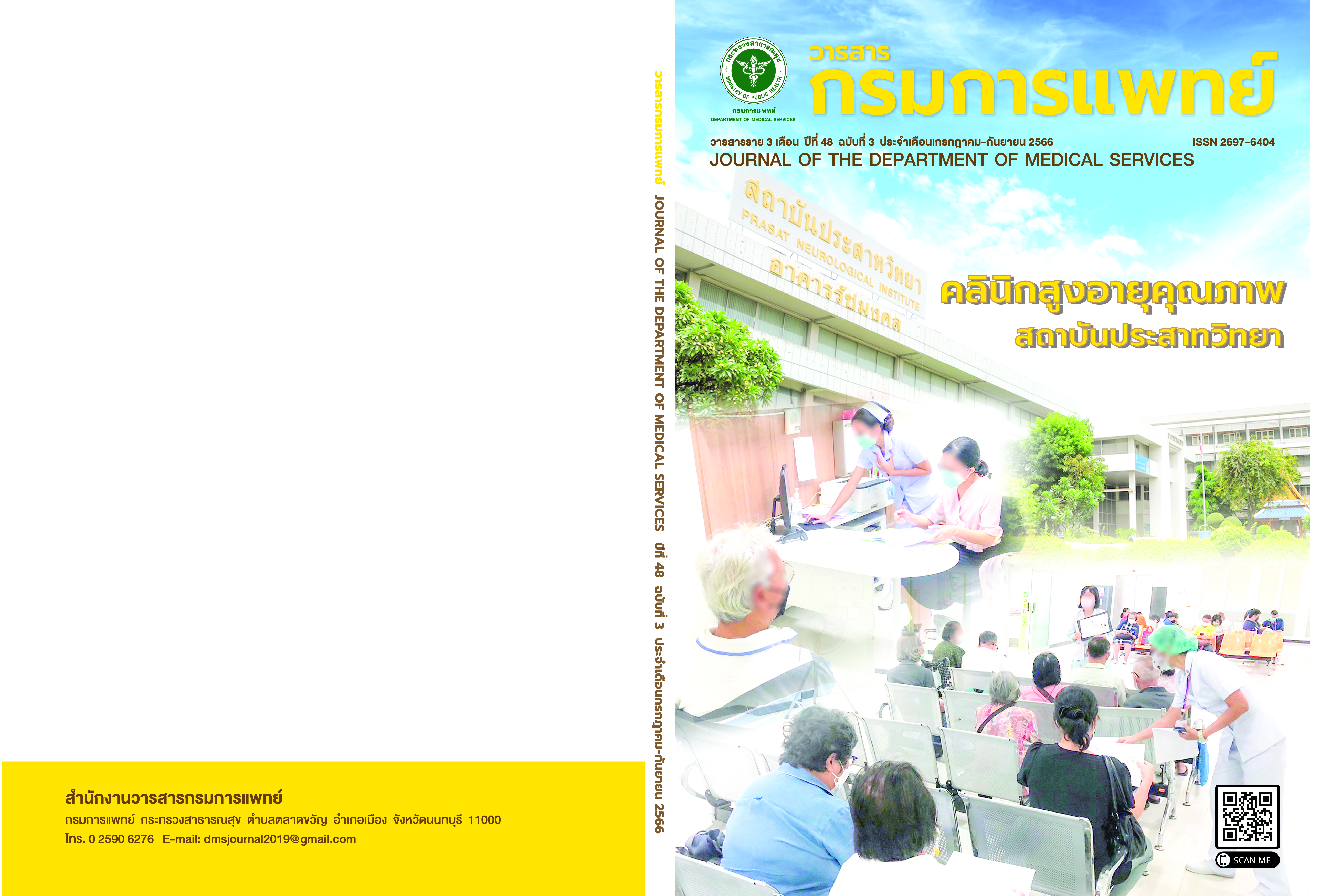ผลของการจัดการด้านโลจิสติกส์ในการกระจายสารน้ำให้ทางหลอดเลือดดำ ณ สถาบันสุขภาพเด็กแห่งชาติมหาราชินี
คำสำคัญ:
การจัดการโลจิสติกส์, ระบบกระจาย, สารน้ำให้ทางหลอดเลือดดำบทคัดย่อ
ภูมิหลัง: สถาบันสุขภาพเด็กแห่งชาติมหาราชินี มีระบบการกระจายสารน้ำให้ทางหลอดเลือดดำจากคลังน้ำเกลือไปยังหอผู้ป่วยและหน่วยงานต่างๆโดยงานบริการเภสัชกรรมผู้ป่วยในบริหารจัดการคลังน้ำเกลือ ซึ่งต้องมีปริมาณสารน้ำให้ทางหลอดเลือดดำสำรองให้เพียงพอสำหรับทุกหน่วยเบิก ทำให้มูลค่าคงคลังซึ่งจัดเป็นต้นทุนของหน่วยบริการมีค่าสูงมาก จึงมีแนวคิดนำการจัดการด้านโลจิสติกส์มาประยุกต์ใช้ในการกระจายสารน้ำให้ทางหลอดเลือดดำ วัตถุประสงค์: เพื่อลดปริมาณสำรองสารน้ำให้ทางหลอดเลือดดำมูลค่าคงคลัง และลดการใช้ทรัพยากรและบุคลากรของสถาบันฯ ในการกระจายสารน้ำให้ทางหลอดเลือดดำ โดยการพัฒนาระบบการกระจายสารน้ำให้ทางหลอดเลือดดำด้วยการจัดการด้านโลจิสติกส์ในการนำส่งสารน้ำให้ทางหลอดเลือดดำไปยังหน่วยงานที่เบิก โดยไม่ใช้บุคลากรของสถาบันฯ เป็นผู้นำส่ง วิธีการ: เป็นการศึกษาเชิงพรรณนาโดยการพัฒนาระบบการกระจายสารน้ำให้ทางหลอดเลือดดำด้วยการจัดการด้านโลจิสติกส์ในการนำส่งสารน้ำให้ทางหลอดเลือดดำไปยังหน่วยงานที่เบิก และเก็บข้อมูลการเบิกจ่ายสารน้ำให้ทางหลอดเลือดดำของ 25 หน่วยงาน มูลค่าสำรองคงคลังน้ำเกลือ มูลค่ารวมที่จ่ายออกจากคลัง จำนวนเดือนสำรองสารน้ำให้ทางหลอดเลือดดำระยะเวลาในการเบิกจ่ายสารน้ำให้ทางหลอดเลือดดำ โดยเปรียบเทียบข้อมูลจากการใช้ระบบใหม่ (กันยายน พ.ศ. 2563) กับระบบเดิม (กันยายน พ.ศ. 2561) ด้วยสถิติเชิงพรรณนา แสดงปริมาณ ความถี่ และร้อยละ ผล: ระบบใหม่ช่วยเพิ่มประสิทธิภาพในการจัดคลังน้ำเกลือได้ดีกว่าระบบเดิม โดยสามารถทำให้มูลค่าคงคลังจำนวนเดือนสำรองและระยะเวลาในการเบิกจ่าย ลดลงร้อยละ 39.74, 48.79 และ 26.47 ตามลำดับ เจ้าหน้าที่ของหน่วยงานที่เบิกสารน้ำให้ทางหลอดเลือดดำ และเจ้าหน้าที่ในกลุ่มงานเภสัชกรรมยังมีความพึงพอใจอย่างมาก จากผลประเมินความพึงพอใจโดยรวมร้อยละ 75 และร้อยละ 86 ตามลำดับ สรุป: การพัฒนาระบบการกระจายสารน้ำให้ทางหลอดเลือดดำ โดยนำการจัดการด้านโลจิสติกส์มาใช้ในการขนส่งสารน้ำให้ทางหลอดเลือดดำจากบริษัทผู้จำหน่ายไปยังหน่วยงานปลายทางที่เบิกสารน้ำให้ทางหลอดเลือดดำโดยตรงช่วยเพิ่มประสิทธิภาพในการจัดคลังน้ำเกลือ โดยสามารถลดมูลค่าคงคลัง จำนวนเดือนสำรองและระยะเวลาในการเบิกจ่าย เจ้าหน้าที่มีความพึงพอใจ ส่งเสริมให้เกิดการใช้ทรัพยากรและบุคลากรอย่างมีประสิทธิภาพ
เอกสารอ้างอิง
Logistics and supply chain management. School of management King Monkut’s University of Technology Thonburi. Bangkok: A-Print and Pack Co., Ltd.; 2016.
Azzi A, Persona A, Sgarbossa F, Bonin M. Drug inventory management and distribution: outsourcing logistics to third-party providers. Strategic Outsourcing: An International Journal 2013;6(1):48-64.
Jawab F, Frichi Y, Boutahari S, Hospital Logistics Activities.In IEOM Society International Bandung, Indonesia, (March 6-8, 2018).
OLIVEIRA, Alves RD, LIMA, Mendes V, FRANÇA Cavalcante FD, et al. Hospital pharmacy management: Logistics focus on the supply chain. Revista Científica Multidisciplinar Núcleo do Conhecimento 2020;3:87-9.
Kritchanchai D. The research project research for developing logistics system in community hospital. [Dissertation]. Nakhon Pathom: Mahidol University; 2016.
Makepiboon P, Krichanchai S. Effectiveness of vendor-managed inventory system in drug inventory management in sub-district health-promoting hospitals. SEHS 2022;16:1-10.
Intoyos N, Kessomboon N. Improving the inventory management system using modified vendor managed inventory: a case study of primary care units in Klonglan District, Kampaengpetch. JHSR 2013;7(2):241-51.
Sirirattawakin S, Vongmanee V. Increasing efficiency of drugs and medical supplies distribution in hospital using lean thinking: A case study of GGG Co., Ltd. In Graduate School Rangsit University, editors. Proceedings of the 16th RSU National Graduate research Conference. Pathumthani: Rangsit University; 2021.p. 641-52.
Dankamned W, Niemsakul J. Transportation planning for medical products in hospital, A case study of large public hospital in Thailand. J Ind Tech 2020;16(2):1-13.
Paoin P, Donkwa K. A study of drug supply chain management system between Pakthongchai and Bangkok-Ratchasima hospital. Suranaree J Soc Sci 2016;10(1):65-81.
ดาวน์โหลด
เผยแพร่แล้ว
รูปแบบการอ้างอิง
ฉบับ
ประเภทบทความ
สัญญาอนุญาต
ลิขสิทธิ์ (c) 2023 กรมการแพทย์ กระทรวงสาธารณสุข

อนุญาตภายใต้เงื่อนไข Creative Commons Attribution-NonCommercial-NoDerivatives 4.0 International License.
บทความที่ได้รับการตีพิมพ์เป็นลิขสิทธิ์ของกรมการแพทย์ กระทรวงสาธารณสุข
ข้อความและข้อคิดเห็นต่างๆ เป็นของผู้เขียนบทความ ไม่ใช่ความเห็นของกองบรรณาธิการหรือของวารสารกรมการแพทย์



